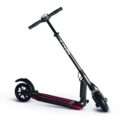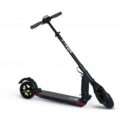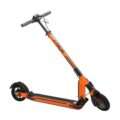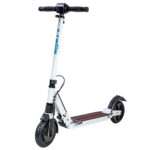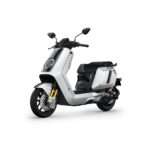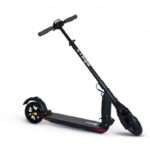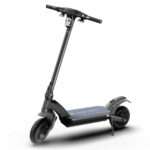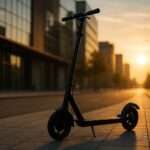- Home
- Scooters
- Electric Scooters
- E-TWOW Booster ES
E-TWOW Booster ES
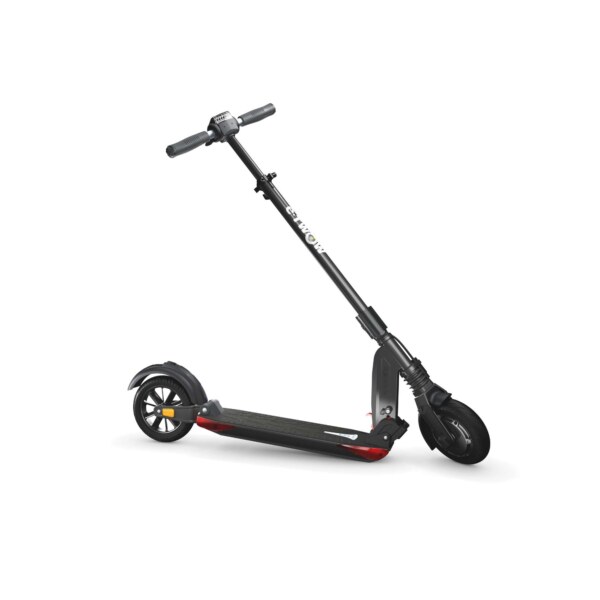


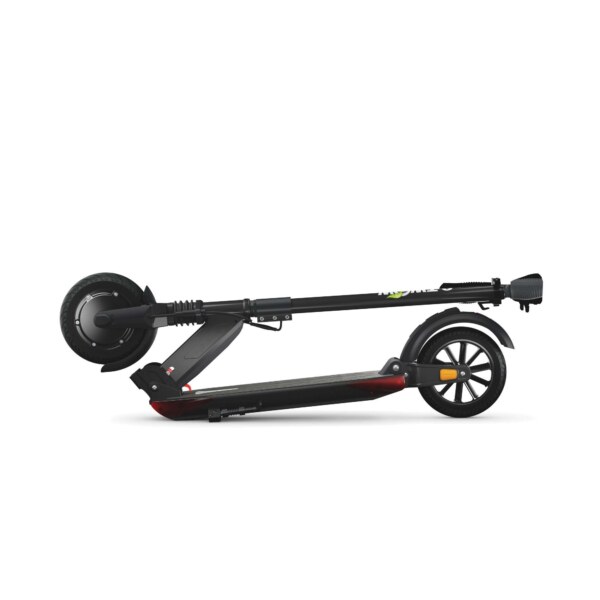
- Battery Range: 16–19 miles (25–30 km)
- Top Speed: 18.6 mph (30 km/h)
- Motor Power: 500 W
- Weight Capacity: 242 lb (110 kg)
- Charging Time: ~2–3 h
- Scooter Weight: 25.6 lb (11.6 kg)
PROS
- Lightweight and compact
- 500W motor with KERS regen
- Front & rear suspension
- Bluetooth app with lock/speed limit
- Optional rear drum brake configuration
CONS
- Solid 8″ tires transmit bumps
- Range is commuter-oriented. not long-distance
- Factory speed limits may apply in some regions
Key Takeaways
- The E-TWOW Booster ES is a lightweight, compact commuter scooter ideal for city riders and last-mile travel.
- It features solid 8-inch tires, dual spring suspension, and quick foldability for easy storage and transport.
- With a 36 V battery, it offers a maximum speed of 25 km/h and a range suited for short to medium city trips.
- The scooter incorporates regenerative braking and has a simple control interface for ease of use.
- It’s best for commuters who prioritize portability over speed, while not suitable for heavy hill routes or long-distance rides.
Table of contents
- What Is the E-TWOW Booster ES?
- How the E-TWOW Booster ES Works
- Key Specifications
- Design & Build Quality
- Performance Fundamentals
- Battery, Range & Efficiency
- Ride Quality & Comfort
- Braking & Safety Features
- Portability & Daily Usability
- Maintenance & Care
- Weather & Seasonal Considerations
- E-TWOW Booster ES vs Alternatives
- Who the E-TWOW Booster ES Is (and Isn’t) For
- FAQs
- Glossary
- Final Notes on Daily Use
- E-TWOW Booster ES vs Your Commute: A Quick Checklist
Light. Quick. Fold-and-go. The E-TWOW Booster ES is a compact commuter scooter that trades bulk for real portability. It suits city riders, students, and anyone who needs a fast last-mile hop that slides under a desk or into a small trunk. If you want a close sibling, the E-TWOW S2 Booster rides in the same ultra-light lane, and it keeps the same fold-first idea.
You get a clean spec table in both metric and imperial units. You also get care tips, seasonal advice, and straight answers to common questions. The goal is simple. Help you tell if this scooter fits your route and your space.
What Is the E-TWOW Booster ES?
The E-TWOW Booster ES is a lightweight stand-up scooter with 8-inch solid tires and dual spring suspension. The design puts portability first, and it shows. Weight sits in the low-to-mid 20s in pounds, which makes stairs and transit stops much easier.
The fold takes seconds. Flip the latch, drop the stem, and hook it to the rear fender. Then fold the grips to cut width. This small footprint helps in cafés, elevators, and classrooms. At the same time, the adjustable stem lets short and tall riders find a relaxed bar height.
Range covers short and medium city trips. You cruise in the 15–18 mph range, or 25–30 km/h where rules allow. So the scooter slots into bike-lane flow on flat routes. A front electronic brake with energy recovery handles most stops. A rear fender friction brake backs it up when you need a firmer bite.
The cockpit keeps things simple. A central LCD shows speed, mode, and battery bars. The right thumb throttle handles pace. The left lever triggers regen. After a few days, you ride by feel and glance down only now and then.
How the E-TWOW Booster ES Works
The system has five core parts. The motor, the controller, the battery, the throttle, and the brakes. Each part does a clear job that joins into one riding rhythm.
Motor. A front hub motor drives the wheel directly. There is no belt or chain. So response feels instant when you press the throttle, and noise stays low.
Controller. The controller meters current to the motor and blends in regen when you brake. Then it caps speed per mode to match local rules or your own comfort.
Battery. A 36 V lithium pack sits in the deck. Capacity lands in the sub-300 Wh class, which keeps weight down. Charge time stays short on the stock brick.
Throttle. A right-side thumb throttle lets you make fine speed changes. It pairs well with cruise control on flat paths. Longer stretches feel relaxed, and your thumb gets a break.
Brakes. The front motor handles regenerative braking with strength you can set. A rear fender friction brake adds a mechanical backup. Use both together for the shortest stops in the wet.
Key Specifications
The table compiles official core facts in a tidy view. Values list metric first with imperial in parentheses, so you can compare at a glance without extra math. These specifications may vary a touch by revision.
| Block | Item | Value |
|---|---|---|
| General | Model | E-TWOW Booster ES |
| Wheel size | 8 in solid rubber. Front and rear | |
| Suspension | Dual springs. Front and rear | |
| Max rider load | 100–110 kg (220–242 lb) | |
| Performance & Power | Motor | Front hub. 36 V class. ~500 W nominal |
| Top speed | 25 km/h EU cap (15.5 mph). Up to ~30 km/h where allowed (18.6 mph) | |
| Climb ability | Short urban grades around 7–10% with a light rider | |
| Battery, Charging & Electrical | Battery | ~36 V. ~7.8 Ah. ~280 Wh |
| Charger | 42 V output. ~2 A | |
| Charge time | About 3–4 h from low | |
| Energy recovery | KERS regenerative braking. User-selectable strength | |
| Build & Dimensions | Weight | About 10.8–11.3 kg (24–25 lb) |
| Unfolded size | ~94–116 cm length/height range due to adjustable stem (37–46 in) | |
| Folded size | ~94 × 33 × 15 cm (37.0 × 13.0 × 6.0 in) | |
| Deck size | Narrow commuter deck. ~42–45 cm long (16.5–17.7 in) | |
| Safety & Control | Brakes | Front electronic regen. Rear fender friction |
| Lighting | High-output front LED. Rear LED with brake light | |
| IP rating | No stated rating on early units. Use care in rain | |
| Features & Extras | Display | Backlit LCD. Speed. Battery. Mode. Trip |
| Modes | Multiple speed modes. Cruise control | |
| Handlebars | Foldable grips for compact storage | |
| Warranty & Compliance | Warranty (EU) | Up to 2 years on scooter. Battery may differ by region |
| Compliance | CE. RoHS. Local speed rules vary |
So you get a small, sturdy frame with a light battery and quick-fold parts. These specifications explain why it carries well and charges fast.
Design & Build Quality
The frame uses a square-section alloy extrusion with clean welds and a flush deck plate. The deck rides low, and that lowers the center of gravity. Straight tracking improves, and quick turns feel easy. A grippy rubber mat covers the deck, which means cleanup takes one quick wipe after a wet ride.
The stem adjusts for height with a firm clamp. Pick a notch that keeps your elbows soft. Then close the latch with a solid cam action. Play at the joint stays minimal when the clamp is snug. Still, it is smart to check clamp tightness once a week.
The folding joint sits low near the deck. Pull the lever and drop the stem until it hooks on the rear fender. Then lift the scooter by the stem or the deck cutout. With a little practice, the motion takes a few seconds, which fits quick bus or metro transfers.
The cockpit is tidy. The screen sits in line with the stem. The throttle lives on the right. The brake lever sits on the left. A bell button and a light switch sit under your thumbs. After a week, you can run every control without looking down.
Fit and finish match a commuter focus. Tolerances are tight at the fold and at the bar ends. You can feel a hint of stem flex if you yank side-to-side on purpose. During normal braking and turns, it stays controlled. So the scooter feels calm at city speeds.
Performance Fundamentals
Starts feel smooth. Kick off, press the thumb pad, and the motor ramps with a gentle curve in low mode. A higher mode gives a snappier start. You can pick a feel that matches your route and your taste.
The ES reaches a steady cruise quickly. On flat bike lanes, it tracks straight with light steering. You can lift a hand for a second to signal a turn or nudge a glove, and stability holds through the mid-teens in mph. On broad paths, it feels most planted between 12 and 17 mph.
Hills change the picture. Short ramps in the 7–10% band are fine with a light rider. Long grades slow the scooter, and that is normal for this class. Drop your pace or add a few helper kicks. Regen helps on the way down. Set one notch higher for hilly zones to control speed without heating the rear brake.
Crosswinds and rough joints can nudge the light front end. Bend your knees and keep your elbows soft. The scooter flows over joints with less jolt to your hands. On clean pavement, it glides and stays quiet.
Battery, Range & Efficiency
The deck holds a 36 V pack near 7.8 Ah, which totals around 280 Wh. That size keeps weight low and charge time short. So the ES fits daily commutes under an hour round trip.
Range depends on speed, rider mass, wind, temperature, and stops. Cold days trim range. Warm, calm days extend it. On flat routes at 25 km/h with a 75 kg rider, many users see mid-teens in miles. Heavier riders or higher speeds land lower. Plan a small buffer, and try to finish with one bar left.
Charging is simple. The 42 V stock brick outputs about 2 A. From low, the scooter needs roughly 3–4 hours. For daily use, charge near full and unplug. For storage longer than a week, park it around half and top up monthly.
Cell care matters. Do not leave the pack full in a hot car. Do not store it empty for long. Charge after rides and let the scooter rest indoors. Those easy habits keep capacity healthier across seasons.
Ride Quality & Comfort
Solid 8-inch tires remove puncture risk. They also pass more texture from the road, which you will feel in your feet and hands. Dual springs cushion sharp hits from joints and shallow potholes. The ride feels firm but controlled on city asphalt.
Foot space is narrow compared with bigger touring scooters. A staggered stance helps a lot. Place your front foot near the deck head and your rear foot across the tail. Then shift weight forward for turns and back for bumps. Pressing slightly over the front calms quick S-turns on bike paths.
Stem flex shows up under hard braking or fast chicanes. In straight runs, it stays minor. Keep both hands on the bar over broken patches. The scooter holds its line, and your grip stays relaxed.
Vibration rises on coarse chip seal. Drop a few mph and let the springs do their job. On fresh pavement, the scooter feels smooth and easy.
Braking & Safety Features
Regen braking slows the front wheel and feeds energy back into the battery. The feel is smooth and predictable. Squeeze the lever and the scooter digs in a bit harder. You can set strength in the menu. Medium suits flat routes. A higher level helps on hills or in wet weather.
The rear fender works as a friction brake. Step on it for emergency stops or extra torque at low speed. Practice both brakes together in a safe lot. Learn the feel at 10 mph, 15 mph, and 18 mph before traffic throws a surprise.
The headlight throws a bright white beam. Aim it slightly down so you do not glare oncoming riders. The rear light glows and brightens on brake. Side reflectors add passive visibility, which is handy at dusk.
Water resistance is not the main focus on this model. Light spray is fine. Deep puddles are a bad idea. Slow down in rain, ride straighter, and dry the scooter afterward.
Portability & Daily Usability
Portability is the star here. Weight sits around 10.8–11.3 kg. Many riders can carry it in one hand for a flight of stairs. Folded bars cut width, and the scooter slips behind a café chair or under a desk.
The fold is quick. Flip the safety, pull the lever, and swing the stem down. It hooks to the rear fender and stays put. Lift by the stem or the deck cutout and go. It is a smooth routine once you get it down.
Storage is simple. Lay it flat in a trunk or stand it upright in a closet corner. A silicone strap keeps folded grips from moving during transport. For short stops, loop a small cable lock through the front wheel and frame. That small step lowers risk while you grab a coffee.
Daily habits keep it sharp. Wipe the deck and wheels with a damp cloth. Check tire faces for cuts. Close the charge-port cap before each ride. Little things add up over months.
Maintenance & Care
A short schedule keeps you ahead of wear. Follow the simple plan below and you will avoid most headaches.
Before each ride. Check the stem clamp and tug the bars for play. Tap the brake to confirm regen engages. Press the bell. Glance at the front light.
Weekly. Wipe the scooter clean. Check the rear fender brake for wear or rub. Spin the wheels and listen. Cycle lights on and off.
Monthly. Check fasteners at the folding joint, stem clamp, and bar mounts. A quarter turn can kill a small rattle. Lubricate the folding latch lightly with silicone spray. Wipe off extra, and keep spray off brake surfaces.
Every 3–6 months. Inspect springs and bushings. Look for play at pivot points. Review display settings for KERS level and default mode. Do a full charge to balance the pack.
Battery care. Keep day-to-day use between 20% and 80% when you can. Charge to full for longer trips and ride soon after. Store at half if you will pause for a month.
Weather & Seasonal Considerations
Rain changes grip fast on solid tires. Slow down and brake earlier. Use more regen and add the rear fender gently. Avoid paint lines and metal plates, since they get slick first.
Cold cuts range. A drop from 20 °C to 0 °C can trim several miles. Start with a warm pack. Carry the folded scooter indoors overnight, then leave with a full charge for the morning ride.
Heat stresses batteries and rubber. Park in shade. Let the scooter cool before charging after a long hot climb. Check tire faces more often in summer. Small cuts grow quicker in high heat.
Wind matters. A steady headwind at 25 km/h adds load and reduces range. Tuck elbows a bit and pick wind-sheltered streets when you can.
E-TWOW Booster ES vs Alternatives
In the commuter niche, the ES favors carry ease over brute power. It shines on flat city routes, short car-to-desk hops, and mixed bus-train days. The fold is fast, the frame is light, and the scooter earns its keep in tight spaces. For more punch while staying compact, the E-TWOW GT Sport brings stronger acceleration and a higher ceiling, but it adds a bit of weight and cost.
Bigger commuters bring wider decks, 9–10 inch tires, and stronger brakes. They ride softer on broken asphalt. On the flip side, they weigh 30–40 lb and can feel clumsy on stairs. Portability drops as comfort rises. Pick based on your route.
Performance scooters jump to dual motors and long-travel forks. They sprint hard and crush hills. They also land at 60 lb or more and demand real storage. That class costs more and needs more care, so it serves a different job.
Off-road models use knobby tires and tall frames. They handle dirt and roots well. They lose on weight and fold speed. The ES is a street tool first and is at its best on pavement.
Who the E-TWOW Booster ES Is (and Isn’t) For
Best for. City commuters, students, and last-mile riders who value a 10–11 kg carry more than a 40 km/h top speed. People who fold often and store in tight corners. Multi-modal travelers gain the most.
Good for. Car commuters who park far from the office. Apartment dwellers with limited space. Riders who want simple upkeep and flat-free tires.
Not for. Heavy hill routes or riders who expect brisk speed on long climbs. Long-range users who want 25–30 miles per charge. Trail riders who spend time on dirt and rough gravel. A bigger deck and pneumatic tires fit those jobs better.
FAQs
How fast does the E-TWOW Booster ES go?
It cruises around 25 km/h in regions with speed caps. On private property it can reach the high-teens in mph where rules allow. Expect steady bike-lane pace on flat ground.
What is the real-world range?
On flat routes at city speeds, many riders see mid-teens in miles. Wind, hills, rider mass, and temperature move that number. Plan a small buffer to be safe.
Does it have cruise control?
Yes. Hold a steady speed for a short stretch and the display confirms it. A light brake or throttle change exits cruise right away.
Is it good for hills?
It handles short urban grades at 7–10% with a light rider. Long hills slow the scooter. Add a few kicks to keep flow and save energy.
Can I ride in the rain?
Light spray is fine. Deep puddles are not. Ride slower, brake straighter, and dry the scooter after the commute.
What is included in an E-TWOW Booster ES overview?
You get a spec table, practical setup advice, care tips, and clear ride impressions. That way you can match the scooter to your route.
How much does it weigh, and is daily carry practical?
It weighs about 10.8–11.3 kg. The fold is quick and the stem hooks to the fender. Daily carry up stairs or onto a bus is realistic.
Glossary
Ah (amp-hours). Battery capacity rating that hints at runtime.
Wh (watt-hours). Stored energy. Voltage times amp-hours gives you this.
Controller. The onboard power unit that drives the motor and blends braking.
Regen. Electronic braking that slows the motor and returns some energy to the battery.
KERS. A regen mode that recovers energy during braking or coasting.
Stem flex. Small bending of the handlebar stem under load. Some is normal on light scooters.
IP rating. A code for dust and water protection. Higher digits mean better protection.
Fender brake. A rear friction brake you engage by stepping on the fender.
Cruise control. A function that holds speed until you brake or adjust throttle.
Kick-off. The small push you give before the motor ramps from a stop.
Hub motor. A motor built into the wheel hub that drives the tire directly.
Deck. The platform you stand on during a ride.
Solid tire. A puncture-proof rubber tire without a tube. It rides firmer.
Display. The LCD that shows speed, mode, and battery bars.
Mode. A preset that sets top speed and throttle feel.
Final Notes on Daily Use
Start with a short shakedown route. Learn the start, turn, and stop feel on clean pavement. Add distance day by day, and keep the latch snug. Keep the tires clean, and keep the battery in a healthy window. The scooter will feel quiet and predictable for a long time.
E-TWOW Booster ES vs Your Commute: A Quick Checklist
- Your round trip fits inside a mid-teens mile range.
- Your route is mostly paved and smooth.
- You need to fold often and carry on stairs or transit.
- Your storage at home or work is tight.
- You prefer low care over wide pneumatic tires.
- Your hills are short, or you are fine adding a few kicks.
If most boxes got a yes, the E-TWOW Booster ES will likely fit your life.
Specifications
General
| Model The Model specifies the exact version or name of the scooter. It helps identify its unique design, features, and specifications within the manufacturer’s product line. Knowing the model makes it easier to compare options, find compatible accessories, or look up support information. | Booster ES |
| Brand The Brand identifies the manufacturer or company that designs and produces the scooter. A trusted brand is a sign of quality, reliability, and good customer support. Well-known brands often have higher standards for safety, performance, and after-sales service, giving you more confidence in your purchase. | E-TWOW |
| Release Date The Release Date indicates when the scooter model was officially launched on the market. This helps you know how current the design, technology, and features are. A newer release date often means updated components, improved performance, and the latest safety or smart features. | 18 November 2025 |
| Recommended Age Recommended Age indicates the minimum age range that the scooter is designed for, based on safety, size, and ease of use. Following the recommended age helps ensure that riders can handle the scooter’s speed, weight, and controls comfortably and safely. Always check local laws and use protective gear, especially for younger riders. | +16 |
Performance & Power
| Motor Power (Wattage) What it means: The motor power, measured in watts (W), shows how strong the scooter’s electric motor is. Why it matters: Higher wattage usually means better acceleration, more torque, and improved performance on hills or rough terrain. For example, a 250W motor is good for flat city roads and light riders, while a 500W or 1000W motor provides more power for faster speeds or climbing steep inclines. | 500 W front hub (brushless DC) |
| Top Speed The Top Speed indicates the maximum speed that the scooter can reach under optimal conditions. It’s usually measured on level ground with a fully charged battery and an average rider weight. A higher top speed allows you to travel longer distances faster, but always ensure you ride within legal speed limits and your personal comfort zone for safety. | 18.6 mph (30 km/h); factory limit per local law |
| Battery Capacity Battery Capacity refers to the total amount of energy the scooter’s battery can store, usually measured in ampere-hours (Ah) or watt-hours (Wh). A higher battery capacity means you can ride longer distances on a single charge, reducing the need for frequent recharging. Keep in mind that actual range can vary depending on rider weight, terrain, speed, and weather conditions. | 36 V 7.8 Ah (281 Wh) |
| Estimated Range per Charge The Estimated Range per Charge indicates the average distance the scooter can travel on a single full battery charge. This range is calculated under optimal conditions, such as flat terrain, moderate speed, and average rider weight. Real-world range may vary depending on riding style, terrain, weather, and load. A longer range means fewer recharges and greater freedom for longer trips. | 16–19 miles (25–30 km) |
| Hill Climb Ability Hill Climb Ability describes the maximum incline or slope that the scooter can handle while maintaining stable performance. It’s typically expressed as a percentage or in degrees. A higher hill climb rating means the scooter can tackle steeper hills without losing too much speed or power. Actual climbing performance may vary based on rider weight, battery charge, and terrain conditions. | Up to 20° |
| Drive System The Drive System refers to how power from the motor is delivered to the wheels. Electric scooters typically use either a hub motor (directly integrated into the wheel) or a chain/belt drive system. A high-quality drive system ensures smooth acceleration, efficient power transfer, and low maintenance. The choice of drive system affects performance, noise level, and overall ride experience. | Front hub (FWD) |
Charging & Electrical
| Charging Time Charging Time indicates how long it takes to fully recharge the scooter’s battery from empty to 100% using the standard charger provided. Faster charging means less downtime and more time on the road. Actual charging time may vary slightly depending on battery capacity, charger output, and environmental conditions. | Approx. 2–3 hours (42V/2A or 3A charger) |
| Battery Type Battery Type refers to the specific technology used in the scooter’s battery, which affects performance, lifespan, weight, and charging time. Most modern electric scooters use high-quality lithium-ion (Li-ion) batteries because they offer a good balance of energy density, durability, and low maintenance. A reliable battery type ensures consistent power delivery and longer riding ranges. | Lithium-ion pack with Smart BMS |
| Removable Battery A Removable Battery means the battery pack can be easily detached from the scooter for convenient charging and replacement. This feature allows you to charge the battery separately, swap it with a spare for extended range, or securely store it indoors in extreme weather. Removable batteries add flexibility and make it easier to keep your scooter powered up wherever you are. | Non-removable internal battery (fixed pack) |
| Regenerative Braking Regenerative Braking is an energy-saving feature that converts some of the energy normally lost during braking back into battery power. When you slow down or brake, the motor works in reverse to generate electricity, which helps extend the scooter’s range and improves overall efficiency. This system also reduces wear on traditional brake components, leading to lower maintenance over time. | Yes (via electronic/KERS brake) |
| Lighting Lighting refers to the built-in front and rear lights that enhance visibility and safety when riding in low-light conditions or at night. Good lighting helps you see the road ahead and ensures that other road users can see you. Many scooters include LED headlights, taillights, and sometimes brake lights or side reflectors for added safety and compliance with local traffic regulations. | LED headlight + rear LED/brake + side reflectors |
Build & Dimensions
| Scooter Weight Scooter Weight refers to the total weight of the scooter when fully assembled, including the battery. This affects how easy it is to carry, lift, and store the scooter when not in use. A lighter scooter is more portable and convenient for commuting, especially if you need to carry it upstairs or onto public transport. Keep in mind that a sturdy frame and quality components may add to the weight but also contribute to better durability and ride stability. | 25.6 lb (11.6 kg) |
| Maximum Rider Weight Maximum Rider Weight indicates the highest rider weight that the scooter is designed to safely support while maintaining optimal performance and stability. Staying within this limit helps ensure reliable acceleration, braking, and climbing ability, and it protects the frame, suspension, and motor from excessive strain. Exceeding the recommended limit may reduce performance and increase wear on components. | 242 lb (110 kg) |
| Deck Size Deck Size refers to the dimensions of the scooter’s standing platform. A wider and longer deck provides more foot space, allowing you to stand comfortably and adjust your stance while riding. A well-sized deck improves balance and stability, especially on longer rides or at higher speeds. Compact decks, on the other hand, help keep the scooter lightweight and portable. | Slim. low-deck portable chassis |
| Handlebar Height Handlebar Height refers to the distance from the deck to the handlebars, which affects your riding posture and comfort. An appropriate handlebar height helps you maintain good balance, reduces strain on your back and arms, and makes steering more comfortable. Some scooters have adjustable handlebars to fit riders of different heights, while others have a fixed height for a streamlined design. | Adjustable |
| Folding Mechanism The Folding Mechanism describes how easily and securely the scooter can be folded for carrying and storage. A well-designed folding system lets you quickly collapse the scooter into a compact size, making it convenient to transport on public transit, store under a desk, or fit into a car trunk. Look for sturdy latches and safety locks to ensure the scooter stays firmly in place when folded or unfolded. | 3-point quick fold with folding handlebars |
| Dimensions Folded Dimensions indicate the size of the scooter when it’s fully folded. This measurement shows how much space the scooter will take up when stored or carried, making it easier to check if it will fit in your car trunk, under a desk, or in a closet. Compact folded dimensions are ideal for commuters who need to bring their scooter on public transport or store it in tight spaces. | Folded 980×330×150 mm (38.6×13.0×5.9 in). Unfolded 980×1160×386 mm (38.6×45.7×15.2 in) |
| Material Material refers to the primary construction materials used for the scooter’s frame and key components. High-quality materials like aircraft-grade aluminum, reinforced steel, or durable composites provide strength, stability, and a lighter overall weight. A sturdy material ensures the scooter can handle daily wear and tear while maintaining safety and performance. | Aluminum alloy (6061) |
Safety & Control
| Brake Type(s) Brake Type(s) describe the braking systems the scooter uses to help you slow down or stop safely. Common brake types include mechanical brakes (like drum or disc brakes), electronic brakes, and foot brakes. Many scooters combine multiple braking systems for added safety and shorter stopping distances. The type and quality of brakes affect your control, especially when riding at higher speeds or on slopes. | Front electronic (KERS) + rear drum + rear foot friction |
| Suspension Suspension refers to the system that absorbs shocks and vibrations while riding, providing a smoother and more comfortable ride over uneven or rough surfaces. Scooters may have front suspension, rear suspension, or dual suspension for better shock absorption and stability. Good suspension helps reduce rider fatigue and improves control, especially when riding on bumpy roads or off-road paths. | Front & rear springs |
| Tire Type Tire Type refers to the kind of tires the scooter uses, which directly affects ride comfort, traction, and maintenance. Common types include solid (airless) tires, pneumatic (air-filled) tires, or hybrid options. Pneumatic tires offer better shock absorption and a smoother ride on rough surfaces, while solid tires are puncture-proof and require less upkeep. The right tire type helps ensure safe handling and a comfortable ride in different conditions. | 8″ airless (solid) tires |
| Tire Size Tire Size indicates the diameter and width of the scooter’s tires, which affect ride comfort, stability, and how well the scooter handles different terrains. Larger tires generally offer better shock absorption and a smoother ride over bumps and rough surfaces, while smaller tires keep the scooter lighter and more portable. Choosing the right tire size helps ensure a balance between agility and comfort. | 8-inch |
| Kickstand The Kickstand is a built-in stand that allows you to park your scooter upright when it’s not in use. A sturdy kickstand keeps the scooter stable and prevents it from tipping over, protecting it from scratches and damage. It also makes storing and accessing your scooter more convenient, whether you’re at home, work, or on the go. | Side kickstand |
| Water Resistance Rating Water Resistance Rating indicates how well the scooter is protected against water and moisture, usually shown as an IP (Ingress Protection) rating. This rating helps you understand whether the scooter can handle light rain, splashes, or wet roads without damage. While most scooters are not fully waterproof, a good water resistance rating adds peace of mind when riding in changing weather conditions. Always avoid deep puddles or submerging the scooter to protect its electrical components. | Not specified |
Features & Extras
| Display/Console The Display (or Console) shows important real-time information about your ride, helping you monitor your scooter’s status at a glance. Typical displays show speed, battery level, distance traveled, and riding mode. Some models also include additional features like Bluetooth connectivity, app integration, or backlighting for better visibility at night. A clear and easy-to-read display enhances safety and convenience on every trip. | UBHI color LCD: speed. battery %. odometer. trip. temp |
| Ride Modes Ride Modes refer to the different speed and power settings you can choose to match your riding style or road conditions. Common modes include eco for maximum range and energy efficiency, standard for everyday balance, and sport or turbo for higher speed and stronger acceleration. Switching between ride modes allows you to customize performance, conserve battery, and ride safely in various environments. | Multiple speed-limit presets (6/12/20/25 km/h) |
| Smart App Connectivity Smart App Connectivity lets you pair your scooter with a dedicated mobile app via Bluetooth. Using the app, you can monitor real-time ride stats like speed, battery level, and range, adjust settings such as ride modes or cruise control, lock the scooter for added security, and sometimes receive firmware updates. This feature adds convenience and allows you to personalize your riding experience right from your smartphone. | E-TWOW Connect app: lock. lights. speed limit. Zero Start |
| Anti-Theft System The Anti-Theft System helps protect your scooter from unauthorized use or theft. This feature can include built-in alarms, electronic motor locks, GPS tracking, or remote locking through a mobile app. A good anti-theft system provides peace of mind when parking your scooter in public spaces, adding an extra layer of security to safeguard your investment. | App lock |
| Cruise Control Cruise Control allows you to maintain a steady speed without continuously holding the throttle. This feature makes longer rides more comfortable by reducing hand fatigue and providing a smoother, more relaxed riding experience — especially on flat, open roads or bike lanes. For safety, cruise control can usually be easily activated or deactivated while riding. | Yes (cruise control) |
| Accessories Included Accessories Included lists the additional items that come with the scooter to enhance your riding experience and convenience. Common accessories may include a charger, kickstand, bell, lights, phone holder, or carrying strap. These extras add value by making your scooter safer, easier to use, and ready to ride straight out of the box. | Scooter. charger (42V/2A or 3A). tools. manual |
Warranty & Compliance
| Warranty Period The Warranty Period indicates how long the manufacturer guarantees the scooter against defects in materials and workmanship under normal use. A good warranty provides peace of mind, showing the brand’s confidence in its product quality. Always check what parts are covered, such as the frame, battery, and motor, and follow the maintenance guidelines to keep your warranty valid. | 12 months (region-dependent) |
| Certifications Certifications confirm that the scooter meets specific safety, quality, and environmental standards set by recognized organizations or regulatory bodies. Common certifications may include CE, RoHS, UL, or other local compliance marks, depending on your region. These certifications ensure that the scooter is manufactured to high standards and is safe and legal to use in your country. | Local micromobility compliance (region-dependent) |


